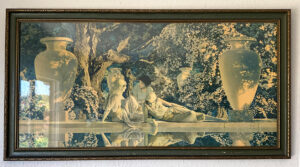Maxfield Parrish Prints a Great Addition to Any Wall
 Maxfield Parrish (1870-1966), an American Quaker master of the fantastic, created a commercial style also recognized as fine art. Known as a book and magazine illustrator in great demand, an advertising man, the creator of a color called “Parrish Blue,” and one of the most popular artists of the 20th century. In 1936 Time magazine listed the three most popular artists, as far as fine art reproductions sales went, Cezanne, Van Gogh, and Parrish.
Maxfield Parrish (1870-1966), an American Quaker master of the fantastic, created a commercial style also recognized as fine art. Known as a book and magazine illustrator in great demand, an advertising man, the creator of a color called “Parrish Blue,” and one of the most popular artists of the 20th century. In 1936 Time magazine listed the three most popular artists, as far as fine art reproductions sales went, Cezanne, Van Gogh, and Parrish.
What does fantastic exotic art have to do with DC, who grew up in a Pedregosa Street 1900s home in Santa Barbara? In the early 1970s she and her brother became enchanted by The Lute Players (1924) and The Garden of Allah, prints by Maxfield Parrish. Let me explain the themes, and why in the 1970s DC fell love with works created in the first quarter of the 20th century.
Equally exotic Maxfield Parrish PrintsI’ll analyze a few of these that stem from a treasured myth:
Circe’s PalaceJason and the Talking OakAltas and The UniverseThe Landing of the Brazen Prince (Prince Agib)Queen Gulnave of the SeasThe Young King of the Black IslesLet’s take a few of these titles and see why the American public, like DC, became enchanted with Parrish. Illustrations. One reproducible work called Circe’s Palace pictures a beautiful seductress. The story, written in the early 19th century by Nathaniel Hawthorne retells the Greek myth of the witch Circe in Homer’s Odyssey. She beguilingly traps sailors on her island, feeds them a magic elixir, and turns them into other-than-humans. The story is filled with repressed desire, lust, loss of self, and exotic faraway places. Lots of blue sky and blue sea as well. Half naked beautiful nymphs and youths in shirtless togas too. Maybe not always togas; sometimes kilts, harem pants, loincloths, as Parrish set the scene for the imagination of the early 20th century.
American DreamsAmericans filled dreams with Persia dark eyed princes, Egyptian blazing bearded sorcerers, and handsome stoic Native American Braves.
In another famous Parrish illustration the gigantic Titan God Altas holds up the world among blue sky and high atmospheric clouds. Altas bears the weight of the world as a punishment for fighting the Olympians. Of course the handsome good shows off a beautiful strong man physique the envy of any young scrawny American farm boy.
The illustration that might have intrigued DC growing up in seaside Santa Barbara, Queen Gulnare of the Sea, shows a beautiful sea creature washed up on the shores of Persia discovered by the handsomest King Hamid. He falls in love with her even though she can’t speak. The image is filled with sorcery, enchantment, magical transformations, and more blue ocean and blue sky too.
Jason and the Talking Oak is modeled after Parrish’s own home in New Hampshire. The Oaks, in which a partially clad youth in 1910 takes advice on love from an ancient tree. This myth joins man and nature at a pivotal time in history before WWI.
The Landing of The Brazen Boatman tells a tale of a young Prince who loves and travels to her father’s palace on a raft. Escapism, sex, lust, and the color blue, the interests of a generation of Americans who never visited a museum.
A Great Addition to Any BookshelfNot only was Parrish a great addition to any wall, but he was also a great addition to any bookshelf. A talented illustrator, he published Arabian Knights: Their Best Known Tales in 1909. In 1910 Parrish published Nathanial Hawthorne’s A Wonder Book and Tanglewood Tales, The Golden Treasury of Songs and Lyrics, The Poems of Childhood. Magazines hired him, Colliers and Hearst’s, and Tire companies asked him to illustrate. When the ad trade began to fizzle, he signed deals for promotional ad calendars with General Electric and Edison Mazda Lamps. He painted themes of nude girls in landscape surroundings.
DC asked if the two prints were of any value. ONLY if those two were vibrant, uncirculated, undisplayed printer’s proofs. So many Parrish images were reproduced that unless you have a printer’s proof or—how unlikely—an original water color. The prints are worth about $200.
The post Maxfield Parrish Prints a Great Addition to Any Wall appeared first on Elizabeth Appraisals.
Elizabeth Stewart's Blog
- Elizabeth Stewart's profile
- 5 followers



